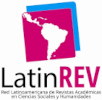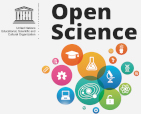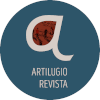1+1=3 G.E. Marx Vigo, a third mind
Keywords:
Mail Art, net, joint-signature, mounting, allegoryAbstract
In the context of the civil-military dictatorship in the Argentine Republic, emergency strategies begin to be produced in order to make known the reality of the country silenced by censorship and the complicity of general public opinion. Correo Art begins to transform into the bastion of resistance to the attacks of repression. In 1976, the son of the plastic artist Edgardo Antonio Vigo, Palomo, was kidnapped from his home. In 1977, Vigo proposed to work as a joint firm with the artist from La Plata, Graciela Gutiérrez Marx, as a form of support to gather strength to communicate what was happening and combat the horror of disappearances. The joint firm was born based on the game of their names merged. The idea of a third mind coined by Vittore Baroni suggests a splitting of subjectivities to try to express what hurts directly, an alter ego that allows witnessing and expressing what trauma does not allow. Faced with the logic of horror promoted by the state, this performative action of reinventing a third level of speech becomes the outlet that allows the process of mourning and a certain melancholy of disaffection.
Downloads
References
Agamben, G. (2000). Lo que queda de Auschwitz. El archivo y el testigo. En Homo Sacer III. Valencia: Pre-Textos.
Bourdieu, P. (1985). The genesis of the Concepts oh Habitus and Field. Sociocriticism. Theories and Perspectives, II(2).
Bürger, P. (1997). Teoría de la Vanguardia. Barcelona: Ediciones Península.
Camnitzer, L. (2008). Didáctica de la liberación. Arte conceptualista latinoamericano. Montevideo: Casa editorial HUM.
Didi-Huberman, G. (2006). La imagen arde. En L. Zimmermann et al., Pensar por las imágenes. Alrededor del trabajo de Georges Didi-Huberman (pp. 11-52). Nantes: Editions Cécile Defaut.
Didi-Huberman, G. (2008). Ante el tiempo. Buenos Aires: Adriana Hidalgo Editora.
Foucault, M. (1980). Microfísica del poder. Madrid: La Piqueta.
García, L. (2011). Políticas de la memoria y de la imagen. Ensayos sobre una actualidad político cultural. Santiago: Universidad de Chile, Colección TEORÍA 23.
Gutiérrez Marx, G. (2010). Arte Correo: Artistas invisibles en la red postal. 1975-1995. Buenos Aires: Luna Verde Ediciones.
Rancière, J. (2005). Sobre políticas estéticas. Barcelona: Servei de Publicacions de la Universitat Autónoma de Barcelona.
Fuentes
Baroni, V. (2007). de G.G. MARX a G. E. MARX-VIGO. Grupo de estudio e investigación de los fenómenos contemporáneos. http://www.geifco.org/actionart/actionart03/secciones/2signo/artistas/delSignoAlObjeto/ggMarx/vigoGG/index.htm
Published
How to Cite
Issue
Section
ARK
License
Copyright (c) 2024 Alicia Madoery

This work is licensed under a Creative Commons Attribution-NonCommercial-ShareAlike 4.0 International License.
















